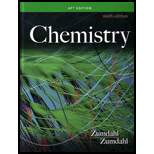
Concept explainers
Hydrogen peroxide is used as a cleansing agent in the treatment of cuts and abrasions for several reasons. It is an oxidizing agent that can directly kill many microorganisms; it decomposes on contact with blood, releasing elemental oxygen gas (which inhibits the growth of anaerobic microorganisms); and it foams on contact with blood, which provides a cleansing action. In the laboratory, small quantities of hydrogen peroxide can be prepared by the action of an acid on an alkaline earth metal peroxide, such as barium peroxide:
What mass of hydrogen peroxide should result when 1.50 g barium peroxide is treated with 25.0 mL hydrochloric acid solution containing 0.0272 g HCI per mL? What mass of which reagent is left unreacted?
Interpretation: The amount of hydrogen peroxide that can be produced by the given chemical reaction is to be calculated. The mass of the unreacted reagent is to be calculated.
Concept introduction: The mass of a substance can be obtained by using the number of moles of the substance present and its molar mass. The formula used to calculate the mass of a given substance is,
To determine: The mass of hydrogen peroxide that can be produced by the given chemical reaction and the mass of the unreacted reagent.
Answer to Problem 119E
The amount of hydrogen peroxide that can be produced is
Explanation of Solution
To determine: The mass of hydrogen peroxide that can be produced by the given chemical reaction
Given
The stated chemical reaction is,
The given mass of
The given volume of
The solution contains
The molar mass of
Formula
The number of moles of a substance is calculated by the formula,
Substitute the value of the given mass and the molar mass of
The solution contains
Therefore, the mass of
The molar mass of
According to the stated reaction,
The moles of
Therefore, some amount of
Barium oxide
According to the stated reaction,
Molar mass of
The mass of a substance is calculated by the formula,
Substitute the value of the number of moles of
To determine: The unreacted amount of the starting material.
Given
The stated chemical reaction is,
The given mass of
The given volume of
The solution contains
The molar mass of
Formula
The number of moles of a substance is calculated by the formula,
Substitute the value of the given mass and the molar mass of
According to the stated reaction,
The moles of
Therefore, some amount of
The moles of
Substitute the values of the given moles of
Molar mass of
The mass of a substance is calculated by the formula,
Substitute the value of the number of moles of
The amount of hydrogen peroxide that can be produced is
The unreacted reagent is
Want to see more full solutions like this?
Chapter 3 Solutions
Chemistry (AP Edition)
- V Biological Macromolecules Drawing the Haworth projection of an aldose from its Fischer projection Draw a Haworth projection of a common cyclic form of this monosaccharide: H C=O HO H HO H H OH CH₂OH Explanation Check Click and drag to start drawing a structure. Xarrow_forwardComplete the mechanismarrow_forwardComplete the mechanismarrow_forward
- 8 00 6 = 10 10 Decide whether each of the molecules in the table below is stable, in the exact form in which it is drawn, at pH = 11. If you decide at least one molecule is not stable, then redraw one of the unstable molecules in its stable form below the table. (If more than unstable, you can pick any of them to redraw.) Check OH stable HO stable Ounstable unstable O OH stable unstable OH 80 F6 F5 stable Ounstable X Save For Later Sub 2025 McGraw Hill LLC. All Rights Reserved. Terms of Use | Privacy C ཀྭ་ A F7 매 F8 F9 4 F10arrow_forwardJust try completing it and it should be straightforward according to the professor and TAs.arrow_forwardThe grading is not on correctness, so if you can just get to the correct answers without perfectionism that would be great. They care about the steps and reasoning and that you did something. I asked for an extension, but was denied the extension.arrow_forward
- Show your work and do something that is reasonable. It does not have to be 100% correct. Just show something that looks good or pretty good as acceptable answers. Something that looks reasonable or correct would be sufficient. If you can get many of them correct that would be great!arrow_forwardShow your work and do something that is reasonable. It does not have to be 100% correct. Just show something that looks good or pretty good as acceptable answers. Something that looks reasonable or correct would be sufficient. If you can get many of them correct that would be great!arrow_forwardTake a look at the following molecule, and then answer the questions in the table below it. (You can click the other tab to see the molecule without the colored regions.) with colored region plain 0= CH2-0-C-(CH2)16-CH3 =0 CH-O-C (CH2)7-CH=CH-(CH2)5-CH3 D CH3 | + OMPLO CH3-N-CH2-CH2-0-P-O-CH2 B CH3 A Try again * 000 Ar 8 0 ?arrow_forward
 Introductory Chemistry: A FoundationChemistryISBN:9781337399425Author:Steven S. Zumdahl, Donald J. DeCostePublisher:Cengage Learning
Introductory Chemistry: A FoundationChemistryISBN:9781337399425Author:Steven S. Zumdahl, Donald J. DeCostePublisher:Cengage Learning General Chemistry - Standalone book (MindTap Cour...ChemistryISBN:9781305580343Author:Steven D. Gammon, Ebbing, Darrell Ebbing, Steven D., Darrell; Gammon, Darrell Ebbing; Steven D. Gammon, Darrell D.; Gammon, Ebbing; Steven D. Gammon; DarrellPublisher:Cengage Learning
General Chemistry - Standalone book (MindTap Cour...ChemistryISBN:9781305580343Author:Steven D. Gammon, Ebbing, Darrell Ebbing, Steven D., Darrell; Gammon, Darrell Ebbing; Steven D. Gammon, Darrell D.; Gammon, Ebbing; Steven D. Gammon; DarrellPublisher:Cengage Learning Chemistry: An Atoms First ApproachChemistryISBN:9781305079243Author:Steven S. Zumdahl, Susan A. ZumdahlPublisher:Cengage Learning
Chemistry: An Atoms First ApproachChemistryISBN:9781305079243Author:Steven S. Zumdahl, Susan A. ZumdahlPublisher:Cengage Learning Chemistry: The Molecular ScienceChemistryISBN:9781285199047Author:John W. Moore, Conrad L. StanitskiPublisher:Cengage Learning
Chemistry: The Molecular ScienceChemistryISBN:9781285199047Author:John W. Moore, Conrad L. StanitskiPublisher:Cengage Learning Chemistry for Engineering StudentsChemistryISBN:9781337398909Author:Lawrence S. Brown, Tom HolmePublisher:Cengage Learning
Chemistry for Engineering StudentsChemistryISBN:9781337398909Author:Lawrence S. Brown, Tom HolmePublisher:Cengage Learning





